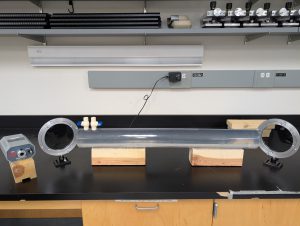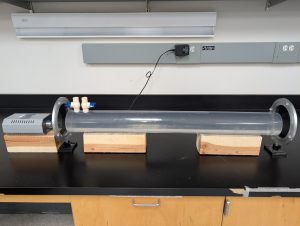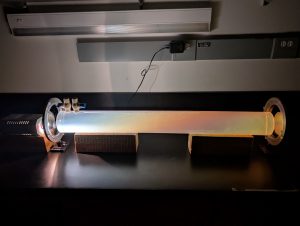Barber Pole Effect
Overview: When polarized light passes through a tube filled with sugar water it creates a rainbow when viewed from the side. Rotating the polarized light makes the rainbow twist in the appearance of a barber pole.
Supplies: Cylindrical tube of sugar water, 2 stands, 2 rotating polarizers, white light source, white screen
Objectives: What is polarization? What effect does a polarizer have on the look of how white light passes through sugar water?
Setup:
- Set the tube of sugar water on the 2 stands
- Place the rotating polarizers, on their stands, at each end of the tube
- Place the white light source, on its stand, at one end of the tube
- Place the white screen at the other end of the tube


How to run the demo:
- Turn on the light source
- Rotate the polarizer near the light source
- View the tube from the side and observe the “barber pole effect” of colors rotating through the sugar water
- Rotate either polarizer to change the color on the screen

What’s Happening?
Light is a traveling electromagnetic wave. These electric and magnetic fields travel through space at the speed of light. The orientation of the electric field determines its polarization. Light can be unpolarized, having no preferred orientation of the electric field, linearly polarized where the electric field traces out a line, or circularly polarized, where the electric field travels in a circle over time.
The demonstration starts with white light passing through a linear polarizer and into the tube of sugar water. The polarizer aligns the white light in one direction. As the aligned light enters the sugar water solution, the solution scatters the light. The circular polarization of the sugar scatters the light in a twisting fashion around the axis of the cylinder as it propagates down the tube. When the light twists, each wavelength twists at different rates creating the diagonal stripe effect when viewed from the side of the tube. The purple wavelength rotates the fastest and the red wavelength rotates the slowest.
By the time the light gets to the other end of the tube, the polarization direction for each wavelength has been separated out from each other. What is interesting to note is that if you look through the end of the tube you cannot see the color separation. The light is still white light and you see it as such. If you add a polarizer at the end, the polarizer will see the different polarization separation. As you rotate the polarizer you can then see different colors on the screen as the polarizer aligns with the different rotations of wavelengths in the tube.
Learn more: (external links)
Learn more: (external links)

